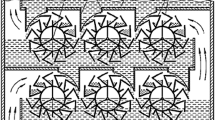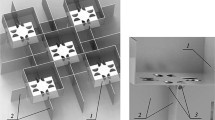A stream-bubble contact device for mass transfer apparatuses that enhances the efficiency of mass transfer processes is proposed. This device uses the energy of liquid streaming from the top downward, which reduces vapor (gas) phase hydraulic resistance. Also, because of reduced separation space, the overall dimensions of mass transfer apparatuses with the installed stream-bubble contact devise decrease. The results of change in torque, with due account of change in characteristic parameters of the contact device, are reported.





Similar content being viewed by others
References
A. G. Laptev, M. I. Farakhov, and N. G. Mineev, Principles of Calculation and Modernization of Heat and Mass Transfer Equipment in Petrochemistry: A Monograph, KGEU, Kazan (2010).
N. Kolev, V. Kralev, and D. Kolev, “Gas side controlled mass transfer in a new packing with stamped horizontal lamellae operating at extremely low liquid loads,” Chem. Eng. Proc.: Proc. Intens., 63, 44–49 (2013).
J. Maćkowiak, “Model for the prediction of liquid phase mass transfer of random packed columns for gas-liquid systems,” Chem. Eng. Res. Design, No. 89 (8), 1308–1320 (2011).
V. Bessou, D. Rouzineau, and M. Prévost, et al., “Performance characteristics of a new structured packing,” Chem. Eng. Sci., No. 65 (16), 4855–4865 (2010).
Z. J. Wei, Z. L. You, and S. Q. Gui, “Gas pressure drop and mass transfer characteristics in a cross-flow rotating packed bed with porous plate packing,” Indust. Eng. Chem. Res., No. 49 (8), 3732–3740 (2010).
B. J. Azzopardi, R. F. Mudde, S. Lo, et al., Hydrodynamics of Gas-Liquid Reactors: Normal Operation and Upset Conditions, Wiley & Sons, New York (2011), 1st ed.
Z. Peter and K. Matthias, Bubble Columns, Wiley-VCH Verlag GmbH & Co. KGaA, Weinheim (2005).
F. S. Allison, Numerical Modeling of Air-Water Flows in Bubble Columns and Airlift Reactors, Blacksburg, Virginia (2010).
M. Behnoosh, G. B. Ensieh, and S. M. Jafar, “Experimental study of gas hold-up and bubble behavior in gas-liquid bubble column,” Petrol. & Coal, No. 51 (1), 22–28 (2009).
R. Hansen, Computational and Experimental Study of Bubble Size in Bubble Columns, Esbjerg Inst. Technol., Aalborg Univ. (2009).
N. Karwa, L. Schmidt, and P. Stephan, “Hydrodynamics of quenching with impinging free-surface jet,” Int. J. Heat and Mass Transfer, No. 55 (13–14), 3677–3685 (2012).
Author information
Authors and Affiliations
Corresponding author
Additional information
Translated from Khimicheskoe i Neftegazovoe Mashinostroenie, No. 6, pp. 9–11, June, 2015.
Rights and permissions
About this article
Cite this article
Madyshev, I.N., Dmitrieva, O.S., Dmitriev, A.V. et al. Assessment of Change in Torque of Stream-Bubble Contact Mass Transfer Devices. Chem Petrol Eng 51, 383–387 (2015). https://doi.org/10.1007/s10556-015-0056-6
Published:
Issue Date:
DOI: https://doi.org/10.1007/s10556-015-0056-6




